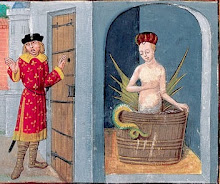 Ignore the weirdness as the waist point. I've fixed that since this photo was taken.
Ignore the weirdness as the waist point. I've fixed that since this photo was taken.The kirtle made of vineyard green linen from fabrics-store.com, and is sewn entirely by hand using period techniques. There's very little evidence of middling types of women wearing separate boned bodies until at least late in the 16th century, so my original plan was to stiffen the bodice of the kirtle itself with hemp cord. I changed my mind, though, and decided to make a separate pair of bodies stiffened with reed, thinking it would be a bit more versatile. Here's a photo of the bodies.

The bodies are made of a linen/cotton blend canvas that I got on sale 'cause it's such a blech dust color. They're boned with teeeeeeeeeny little reeds I got from Reconstructing History. They're essentially broom straw. They come coiled up in a huge bunch, and are an enormous pain in the patoot to try and cut down to usable lengths. I machine sewed the boning channels at about 1/4 inch, then filled each channel with 8 lengths of reed. As you can see, it looks pretty cool when it's finished. They're bound with just regular old bias tape in a shocking shade of tangerine. The binding is sewn on by hand. The lacing eyelets are also done by hand in a matching shade of tangerine. The bodies are spiral laced.
The kirtle itself was draped by my fabulous guildmistress and partner in costuming crime, Valerie. The bodice is lined in a light green linen I picked up somewhere for another purpose altogether, which I have now forgotten. The lining and the outside fabric of each individual bodice piece are sewn to each other by turning in and pressing the seam allowances, then edge stitching the pieces. The backs and the front are then whipstitched to each other at the side and shoulder seams as seen here:
Inside of seam
The back of the kirtle is boned with cable ties for a little extra stiffness along the lacing edges. The eyelets are handbound and arranged so the kirtle is spiral laced.
The skirt is two lengths of the same green linen, each hemmed on the selvedge then whipstiched together. It is pleated and whipstitched directly to the bodice with single knife pleats at the side-fronts and double knife pleats in the back. It's about 110 inches around.
Next up is the wool overgown. I'll try to be better about posting the progress photos and descriptions!







